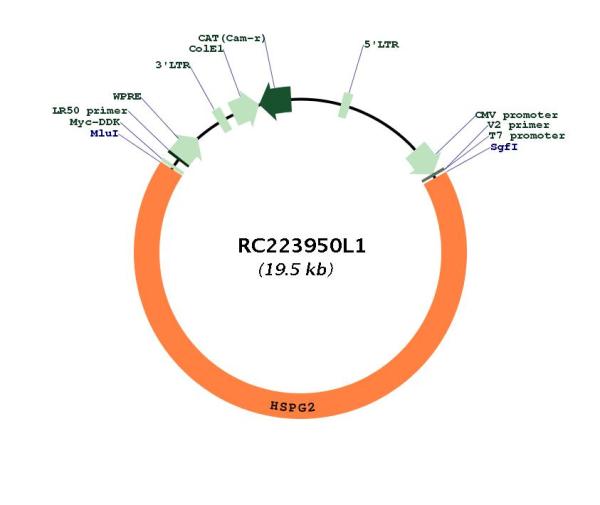Heparan Sulfate Proteoglycan 2 (HSPG2) (NM_005529) Human Tagged Lenti ORF Clone
SKU
RC223950L1
Lenti ORF clone of Human heparan sulfate proteoglycan 2 (HSPG2), Myc-DDK-tagged
-
LentiORF®
LentiORF®
Expression-ready ORF plasmid in lenti backbone
Click here to learn more.
| Product Data | |
| Type | Human Tagged ORF Clone |
|---|---|
| Target Symbol | Heparan Sulfate Proteoglycan 2 |
| Synonyms | HSPG; PLC; PRCAN; SJA; SJS; SJS1 |
| Vector | pLenti-C-Myc-DDK |
| E. coli Selection | Chl (34 ug/mL) |
| Mammalian Cell Selection | None |
| Sequence Data |
ORF Nucleotide Sequence
The ORF insert of this clone is exactly the same as(RC223950).
|
| Restriction Sites |
SgfI-MluI Cloning Scheme for this gene
Plasmid Map

|
| ACCN | NM_005529 |
| ORF Size | 13176 bp |
| OTI Disclaimer | Due to the inherent nature of this plasmid, standard methods to replicate additional amounts of DNA in E. coli are highly likely to result in mutations and/or rearrangements. Therefore, OriGene does not guarantee the capability to replicate this plasmid DNA. Additional amounts of DNA can be purchased from OriGene with batch-specific, full-sequence verification at a reduced cost. Please contact our customer care team at custsupport@origene.com or by calling 301.340.3188 option 3 for pricing and delivery. The molecular sequence of this clone aligns with the gene accession number as a point of reference only. However, individual transcript sequences of the same gene can differ through naturally occurring variations (e.g. polymorphisms), each with its own valid existence. This clone is substantially in agreement with the reference, but a complete review of all prevailing variants is recommended prior to use. More info |
| OTI Annotation | This clone was engineered to express the complete ORF with an expression tag. Expression varies depending on the nature of the gene. |
| Components | The ORF clone is ion-exchange column purified and shipped in a 2D barcoded Matrix tube containing 10ug of transfection-ready, dried plasmid DNA (reconstitute with 100 ul of water). |
| Reconstitution Method | 1. Centrifuge at 5,000xg for 5min. 2. Carefully open the tube and add 100ul of sterile water to dissolve the DNA. 3. Close the tube and incubate for 10 minutes at room temperature. 4. Briefly vortex the tube and then do a quick spin (less than 5000xg) to concentrate the liquid at the bottom. 5. Store the suspended plasmid at -20°C. The DNA is stable for at least one year from date of shipping when stored at -20°C. |
| Note | Plasmids are not sterile. For experiments where strict sterility is required, filtration with 0.22um filter is required. |
| Shipping | Ambient |
| Reference Data | |
| RefSeq | NM_005529.3 |
| RefSeq Size | 14294 bp |
| RefSeq ORF | 13176 bp |
| Locus ID | 3339 |
| UniProt ID | P98160 |
| Cytogenetics | 1p36.12 |
| Domains | EGF, EGF_Lam, IG, ig, IGc2, IGv, LamB, LamG, ldl_recept_a, SEA |
| Protein Families | Druggable Genome |
| Protein Pathways | ECM-receptor interaction |
| MW | 468.91 kDa |
| Summary | This gene encodes the perlecan protein, which consists of a core protein to which three long chains of glycosaminoglycans (heparan sulfate or chondroitin sulfate) are attached. The perlecan protein is a large multidomain proteoglycan that binds to and cross-links many extracellular matrix components and cell-surface molecules. It has been shown that this protein interacts with laminin, prolargin, collagen type IV, FGFBP1, FBLN2, FGF7 and transthyretin, etc., and it plays essential roles in multiple biological activities. Perlecan is a key component of the vascular extracellular matrix, where it helps to maintain the endothelial barrier function. It is a potent inhibitor of smooth muscle cell proliferation and is thus thought to help maintain vascular homeostasis. It can also promote growth factor (e.g., FGF2) activity and thus stimulate endothelial growth and re-generation. It is a major component of basement membranes, where it is involved in the stabilization of other molecules as well as being involved with glomerular permeability to macromolecules and cell adhesion. Mutations in this gene cause Schwartz-Jampel syndrome type 1, Silverman-Handmaker type of dyssegmental dysplasia, and tardive dyskinesia. Alternative splicing of this gene results in multiple transcript variants. [provided by RefSeq, May 2014] |
Write Your Own Review
| Product Manuals |
| FAQs |
| SDS |
Citations
*Delivery time may vary from web posted schedule. Occasional delays may occur due to unforeseen
complexities in the preparation of your product. International customers may expect an additional 1-2 weeks
in shipping.










